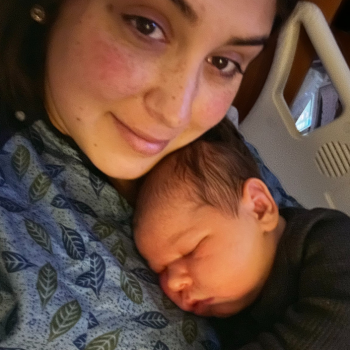
Last Updated on March 05, 2024
Is it just a pregnancy symptom or something more?
Pregnancy is a confusing time. Your body is going through a lot of changes and it can be hard to tell what's normal and what's a red flag. Learning more about the signs and symptoms of preeclampsia, HELLP syndrome and other hypertensive disorders of pregnancy can help you identify a problem early and ensure the best possible outcome.
Some characteristics of preeclampsia are signs that can be measured, but may not be apparent to you, such as high blood pressure. A symptom is something you may experience and recognize, such as a headache or loss of vision.
No Symptoms
Preeclampsia is a serious condition of pregnancy, and can be particularly dangerous because many of the signs are silent while some symptoms resemble “normal” effects of pregnancy on your body. Many women suffering from preeclampsia don’t feel sick, and may be surprised or become frustrated when they are admitted to the hospital or prescribed bed rest since they still feel well.
High blood pressure is an important sign of preeclampsia. The disease is sometimes referred to as a silent killer because most people can’t “feel” their blood pressure going up. As a result, patient awareness of the warning signs is one of the most important tools we have to successfully help women receive the care they need. We encourage you to familiarize yourself with signs and symptoms included here to empower yourself and/or others during pregnancy.
What you can do...
Proper prenatal care is essential so don’t miss your appointments. Your blood pressure and weight should be checked at each prenatal appointment. Your healthcare team may also ask for a urine sample if you have additional risk factors. Do not be afraid to ask your caregiver about your numbers or test results.
A good prenatal diet full of vitamins, minerals and the basic food groups are important for any pregnancy, as is reducing consumption of processed foods, refined sugars and caffeine. Eliminating alcohol and any medication not prescribed by a physician is essential. Report all medications prescribed by other doctors to your prenatal care provider so that these products can be checked regarding their safe use during pregnancy. Speak with your health care professional before taking any nutritional supplement – herbal or otherwise. Although there is no evidence that these healthy behaviors and choices impact preeclampsia, they do optimize your health for the best pregnancy possible.
High blood pressure (Hypertension)
High blood pressure during pregnancy is one of the biggest red flags that preeclampsia may be developing. And even if it's not a symptom of preeclampsia, it can still be a sign of a problem.
High blood pressure is traditionally defined as blood pressure of 140/90 or greater, measured on two separate occasions at least four hours apart. During pregnancy, a rise in the lower number (diastolic) of 15 degrees or more, or a rise in the upper number (systolic) of 30 degrees or more can also be a cause for concern.
What you can do...
Know your blood pressure prior to pregnancy, especially if it's normally considered low. Ask, "What is my blood pressure?" during each prenatal visit with your healthcare provider. (Learn how to take your blood pressure.)
Keep a log of your blood pressure, taken at the same time each day and in the same position. Share your log with your healthcare provider at each visit and notify her immediately if you find any significant rise between visits.
You can buy your own blood pressure monitor at most pharmacies, and some of these stores have a monitor available for your use, though they aren't always reliable. If you own your own monitor, have it calibrated with those used in your provider’s office.
For accuracy, blood pressure readings should be taken in the sitting position, with the cuff positioned on the left arm at the level of the heart. ("Your Blood Pressure: Know the Basics")
Please note that home monitors are not always as accurate as those used in clinics or hospitals. Home readings should never replace prenatal visits, nor should a "normal" reading mean you can ignore other symptoms of preeclampsia.
Some healthcare providers will recommend bed rest for you, even though evidence has not shown it to make a difference in outcomes. Some believe this helps limit potential stressors that could contribute to elevated blood pressures. During late pregnancy, you may be advised to lie on your left side to prevent restriction on certain veins which could also contribute to elevated blood pressure. Healthcare providers do not always agree on the benefits of lying on your side, but there is no evidence of harm.
You may consider seeing or consulting with a specialist in high risk pregnancies. This Maternal Fetal Medicine Physician Locator may help.
Protein in your urine (Proteinuria)
Protein in the urine, or proteinuria, has historically been used as a diagnostic feature of preeclampsia, but some women with preeclampsia may never develop proteinuria. Preeclampsia can still be diagnosed without proteinuria if other severe features are present. (Other severe features of preeclampsia may include low platelets, high levels of liver enzymes in your blood, fluid in your lungs, or severe headache or vision changes that doesn’t go away.)
Most low risk patients may no longer be tested for proteinuria at their regular prenatal check-ups. However, your healthcare provider may still run a simple dipstick test of your urine at some of your appointments if you have other symptoms or they feel you are at higher risk for preeclampsia or other kidney issues unrelated to preeclampsia. Some medical offices may still use blood work, urine protein to creatinine ratio or PCR, or a timed urine collection to measure your kidney function.
Normally, protein is confined to the blood by the filtering role of your kidneys. Preeclampsia may damage this “filter” and cause excess protein to be present in your urine. Most patients who experience kidney dysfunction because of preeclampsia will return to normal within a few months following delivery. Others may need continuing monitoring or treatment.
What you can do...
If your healthcare provider decides to test for protein in your urine, ask for those results to be printed out or made available via your online medical records. A reading of trace protein by dipstick in your urine is relatively common, and is usually not a cause for concern. If the reading is 1+ or greater, it may signal kidney dysfunction and additional confirming tests may be ordered.
Follow guidance from your healthcare provider if they ask you to collect your urine for 12 or 24 hours to determine the exact quantity of protein in the urine. Make every effort to be accurate. In a 24-hour collection, proteinuria is diagnosed when there is at least 300 mg/24h though an amount close to that might be equally concerning. In the case of a protein-creatinine ratio (another way to measure proteinuria), 0.3 generally corresponds to 300 mg in a 24-hour collection.
Swelling (Edema)
A certain amount of swelling is normal during pregnancy. Unless you're one of a lucky few, you may notice a little extra puffiness in your feet (good luck fitting into your pre-pregnancy shoes!). Edema, on the other hand, is the accumulation of excess fluid, and can be a concern when it occurs in your face, around your eyes, or in your hands.
What you can do...
If you think your face is getting excessively puffy, find a picture of yourself from just before pregnancy to share with your healthcare provider. If the swelling in your hands and feet becomes severe, you may notice “pitting edema” (when you press your thumb into your skin, an indentation remains for a few seconds) or discoloration of your legs. If you suspect this kind of edema, notify your healthcare provider. You should also put your feet up every day, but avoid sitting for extended periods of time.
Headaches
Dull or severe, throbbing headaches, often described as migraine-like that just won't go away are cause for concern.
What you can do...
If you have tried taking over-the-counter medication without relief, if the headache is very painful, you have light sensitivity, or if your headache is accompanied by vision changes (please read the section below on "Changes in Vision") call your provider immediately and ask to see him/her that day.
Nausea or Vomiting
Nausea or vomiting is particularly significant when the onset is sudden and after mid-pregnancy. “Morning sickness” should disappear after the first trimester and the sudden appearance of nausea and vomiting after mid pregnancy may be linked to preeclampsia.
What you can do...
Call your care provider. Nausea or vomiting can be confused with the flu or gallbladder problems, so talk to your provider about getting your blood pressure checked, and ask if your urine should be checked for protein.
Abdominal (stomach area) and/or Shoulder Pain
This type of abdominal pain, often called epigastric pain or upper right quadrant (URQ) pain, is usually under the ribs on the right side. It can be confused with heartburn, gallbladder problems, flu, indigestion or pain from the baby kicking. Shoulder pain is often called “referred pain” because it radiates from the liver under the right ribs. Lower back pain is different from muscle strain common to pregnancy, because it is usually more acute and specific. Shoulder pain can feel like someone is deeply pinching you along the bra strap or on your neck, or it can be painful to lie on your right side. All of these pain symptoms may be a sign of HELLP Syndrome or a related problem in the liver.
What you can do...
Pain in this area should be taken very seriously; do not dismiss it and go to bed. Call your health professional immediately.
Lower Back Pain
Lower back pain is a very common complaint of pregnancy. However, sometimes it may indicate a problem with the liver, especially if it accompanies other symptoms of preeclampsia.
What you can do...
Also, watch for Stomach and Right Shoulder Pain (above) and mention this symptom to your health care provider. If this pain accompanies one or more of the other symptoms, you should call your health care provider immediately.
Sudden Weight Gain
Weight gain of more than 3-5 pounds in a week may be an indicator of preeclampsia. Damaged blood vessels allow more water to leak into and stay in your body's tissue and not to pass through the kidneys to be excreted.
What you can do...
Do not try to lose weight during pregnancy by restricting your diet. Eating a healthy, balanced diet, including fresh raw fruit and vegetables, your prenatal vitamin, and a folic acid supplement is important for all pregnancies. Avoid excessive salt. Prior to getting pregnant, achieve a healthy weight (a BMI of 30 or less) since obesity has been shown to increase the chances of getting preeclampsia.
Given that preeclampsia is a complex disease, women will develop it for different reasons. A healthy, balanced diet and optimal weight may make a significant difference for some women. However, we urge caution when considering diets designed for weight-loss or claiming to prevent preeclampsia that encourage large amounts of protein. Excessive dietary protein may cause problems in women with underlying kidney disease.
Be sure to drink sufficient amounts of fluid, usually dictated by your normal thirst sensations, and to perform moderate amounts of exercise regularly. During your prenatal visits do not attempt to disguise weight gain by skipping breakfast, using diet pills or fasting for the day. An accurate weight is vital for a proper diagnosis.
The Preeclampsia Foundation recognizes the importance of a good diet, however we do not recommend any particular diet or juice product.
Changes in Vision
Vision changes are one of the most serious symptoms of preeclampsia. They may be associated with central nervous system irritation or be an indication of swelling of the brain (cerebral edema).
Common vision changes include sensations of flashing lights, auras, light sensitivity, or blurry vision or spots.
What you can do...
If you experience any of these changes in vision, you should contact your healthcare provider immediately or go directly to the hospital. These symptoms are very serious and should not be left unattended, even until the next morning.
Hyperreflexia
Hyperreflexia is when your reflexes are so strong that when your knee is tapped by a rubber “hammer,” your leg bounces back hard. Hyperreflexia is generally caused by an overreaction of the involuntary nervous system to stimulation.
Deep tendon reflexes are increased in many women prior to seizures, but seizures can also occur without hyperreflexia.
What you can do...
This sign is generally measured by a healthcare provider and otherwise difficult for you to observe yourself. Like headache and visual changes, hyperreflexia may indicate changes in your nervous system. Your healthcare provider will let you know if he/she is concerned and whether it is an indication, along with other signs and symptoms, that you should go to the hospital.
If you are under treatment with magnesium sulfate to prevent seizures, your healthcare provider may also test your reflexes to monitor for the need to start, adjust or stop the magnesium treatment. An overdose of magnesium sulfate may suppress or excessively slow your reflexes.
Shortness of breath, anxiety
Shortness of breath, a racing pulse, mental confusion, a heightened sense of anxiety, and a sense of impending doom can be symptoms of preeclampsia. If these symptoms are new to you, they could indicate an elevated blood pressure, or more rarely, fluid collecting in your lungs (pulmonary edema).
What you can do...
Contact your healthcare provider immediately if these symptoms are new. If you've experienced these conditions before pregnancy, be sure to mention them to your care provider during your next visit so they can be monitored closely.

My perfect daughter, Katie, gave birth to her first child just eight days before she passed away due to postpartum complications. Her deliver...
ReadMoreIt is our collective voice that reduces isolation for others, raises awareness and improves healthcare practices. Let's raise up our voices so more women know about preeclampsia and HELLP syndrome and less women have adverse outcomes!
Related Articles

Ánimo y cuídate: la preeclampsia puede estar asociada con enfermedades cardíacas y accidentes cerebrovasculares más adelante en la vida Descargue nuestra hoja informativa

Eclampsia is a very serious complication of preeclampsia characterized by one or more seizures during pregnancy or in the postpartum period.

La preeclampsia, en todas sus formas, puede requerir muchos análisis, tanto durante como después del embarazo. ¿Alguna vez se preguntó por qué el proveedor de atención médica le solicita tantos anális...

El embarazo es un momento ideal para familiarizarse con su presión arterial. Aquí encontrará todo lo que necesita saber sobre cómo tomarse la presión arterial en casa.

Melbourne, FL – September 17 , 2024 – The Preeclampsia Foundation, in partnership with the International Society for the Study of Hypertension in Pregnancy (ISSHP) and Society for Ma...

Resultados de varios estudios apoyan la hipótesis de que el estrés causado por un embarazo y parto traumáticos puede en muchas ocasiones anular la habilidad de salir adelante emoc...

Is there a connection between maternal diet and preeclampsia? The PRECISE Network research team and I recently completed an evidence review to compile information on maternal nutritional factors that...

What you’ll learn in this article: Many risk factors contribute to an individual’s chance of getting preeclampsia. These risk factors may be genetic, physical, environmental, and even s...

Question: Progesterone supplementation - first trimester and beyond - can it help the vascular constriction by keeping the smooth muscle relaxed (17HP shots), and is it associated with early supplemen...




